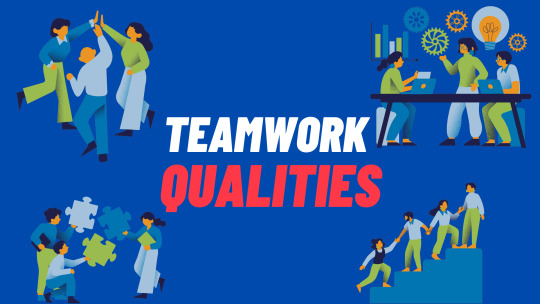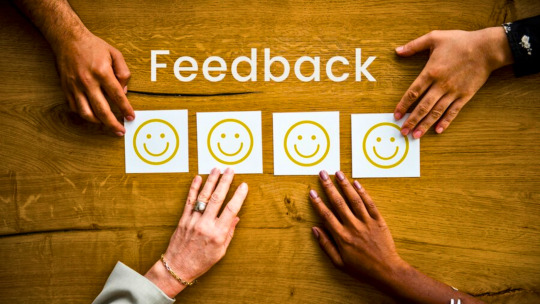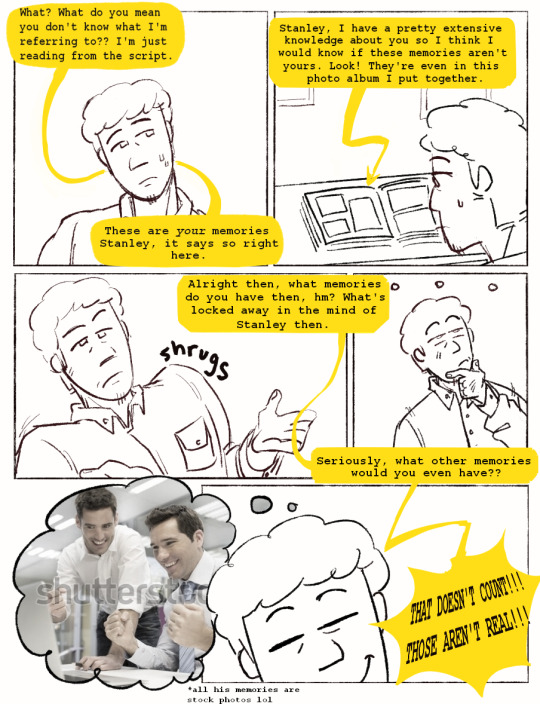#improve teamwork
Explore tagged Tumblr posts
Text
Who Develops the Most Effective Teamwork Qualities?

Teamwork is the cornerstone of success in any organization, but what defines effective teamwork, and who develops these crucial qualities? Is it the charismatic leader steering the ship, the empathetic collaborator promoting connection, or the adaptable problem-solver navigating challenges? In reality, the most effective teamwork skills emerge from a blend of diverse skills, perspectives, and experiences. Whether it’s clear communication, mutual trust, or adaptability under pressure, teamwork thrives when individuals contribute their unique strengths.
This blog explores the traits that build exceptional teamwork, the people who represent them, and the steps anyone can take to cultivate these indispensable skills.
The Natural Leader
Leaders often take the spotlight in discussions about teamwork. However, a leader's ability to create effective teamwork extends beyond simply issuing commands and distributing tasks. Great leaders foster collaboration by building trust, creating clear goals, and motivating team members to work together toward a common vision. Leadership isn’t about commanding—it’s about guiding. The most effective leaders develop teamwork skills by listening actively, providing constructive feedback, and empowering others to shine.
Leaders who excel in teamwork understand that their success lies in the team’s success. They embrace diverse perspectives and leverage each member’s strengths to ensure collective growth.
The Empathetic Collaborator

Empathy is often underestimated but important for developing strong teamwork qualities. Empathetic collaborators create safe spaces for open communication and mutual respect. They prioritize understanding others' perspectives, ensuring each team member feels valued and heard.
This ability to connect emotionally fosters a culture of inclusivity and trust, which is crucial for a team’s success. Empathetic individuals often mediate conflicts effectively, turning potential roadblocks into opportunities for growth. They teach us that teamwork thrives when people feel emotionally secure.
The Adaptable Problem-Solver
The modern workplace is ever-changing, and adaptability is essential for teamwork. Those who can adapt to strategies accept change, and stay solution-focused under pressure are considered adaptable team members. Their flexibility makes them invaluable in high-pressure environments where challenges are inevitable.
Problem-solvers shine brightest in teams because they focus on solutions, not blame. They inspire their teammates to think creatively, explore alternatives, and tackle problems collaboratively. Teams that include adaptable individuals often find themselves better equipped to navigate complexities and deliver results.
The Quiet Yet Reliable Contributor

Not every team member needs to be talkative or assertive. Quieter members possess some of the most effective collaborative qualities—they regularly deliver outcomes, stay organized, and maintain a calm demeanor under pressure. These individuals may not seek the spotlight, but their dependability keeps the workplace productive.
Quiet contributors often develop their teamwork skills through meticulous preparation and attention to detail. They remind us that collaboration isn’t just about speaking up; it’s also about following through.
How Are Teamwork Qualities Developed?
No one is born with all the traits required for effective teamwork. These qualities are cultivated over time through experiences, education, and reflection. Here are some key ways people develop effective teamwork skills:
Learning from Mistakes
Mistakes are valuable teachers. Reflecting on what went wrong and how a team can improve helps build resilience and better collaboration.
Embracing Feedback

Constructive criticism is a cornerstone of growth. Teams that encourage feedback without judgment create an environment of continuous learning.
Practicing Communication
Effective teamwork hinges on clear and honest communication. Teams that prioritize transparency and active listening avoid misunderstandings and build stronger connections.
Encouraging Collaboration
Structured team-building exercises and collaborative teamwork projects help individuals understand each other’s strengths and weaknesses, fostering better synergy.
Adapting to Roles
Recognizing when to lead, follow, or support is a crucial skill for any team member. Flexibility in roles ensures that the team functions efficiently.
Also, watch this video - Boost Workplace Productivity with Employee Monitoring Software
youtube
Conclusion
So, who develops the most effective teamwork skills? The answer is everyone. Leaders, empathetic collaborators, adaptable problem-solvers, and quiet contributors all play vital roles in creating a cohesive and productive team. The magic lies in recognizing the unique qualities each person brings to the table and fostering an environment where those qualities can flourish.
Effective teamwork isn’t about finding perfect individuals—it’s about building a team that complements and supports one another, learning and growing together to achieve shared success. As workplaces continue to evolve, the ability to nurture team building skills will remain an essential skill for professionals across all industries.
0 notes
Text

stock photo memories
shoutout to my friend who finally got me to finish this 👍 would’ve been hidden away in the files 4ever
#the stanley parable#the stanley parable ultra deluxe#tspud#tsp#crows art#ive had this one done for a month now kjgdfkg#actually redraw some of the panels too. improvement and teamwork <3
877 notes
·
View notes
Quote
Speed to fail should be every entrepreneur's motto. When you finally find the one idea that can't be killed, go with it.
Jay Samit
#quotes#Jay Samit#thepersonalwords#literature#life quotes#prose#lit#spilled ink#business-quotes#change#change-your-life#disruption#disruptive-innovation#disruptive-technology#entrepreneur#entrepreneurial#entrepreneurship#innovation#insightful#inspirational#management#management-and-leadership#management-theory#motivational#self-help#self-improvement#social-media#startup#teamwork#technology
24 notes
·
View notes
Quote
You will have more regrets for the things you didn't try than the ones you tried and didn't succeed at.
Jay Samit, Disrupt You!: Master Personal Transformation, Seize Opportunity, and Thrive in the Era of Endless Innovation
#Jay Samit#Disrupt You!: Master Personal Transformation#Seize Opportunity#and Thrive in the Era of Endless Innovation#quotelr#quotes#literature#lit#business-quotes#change#change-your-life#disruption#disruptive-innovation#disruptive-technology#entrepreneur#entrepreneurial#entrepreneurship#innovation#insightful#inspirational#management#management-and-leadership#management-theory#motivational#self-help#self-improvement#social-media#startup#teamwork#technology
17 notes
·
View notes
Text
Dawn of DC panel at SDCC, for B&R 2023 Williamson says Damian’s joining the soccer team in high school 😭 i hope he’s having fun im so happy 😭
#i feel like a mom he’s grown so much he was a 10 yo like a week ago 😭#anyway IM SO EXCITED HE GETS TO DO SOMETHING NORMAL#he can live the shonen sports dream of teamwork and improving a skill#also Shush is a thing now lol#rambling
12 notes
·
View notes
Text
I practice sports, I do not watch them
Daily writing promptWhat Olympic sports do you enjoy watching the most?View all responses While the Olympic Games ignite a global passion for sports, I confess, I find myself on the fringe of the cheering crowd. Throughout my life, I’ve gravitated towards the active side of sports – the dedication of training, the thrill of pushing my limits, and the camaraderie forged in sweat and competition.…

View On WordPress
#camaraderie#commitment#dailyprompt#dailyprompt-1898#dedication#ethic#exceed your limits#excellence#expectations#Grow#Growth#improvement#learning#Martial Arts#Olympic Games#Olympics#Paris 2024#Raffaello Palandri#respect#sport#sports#sportsmanship#strength#strive#teamwork#Training#work ethic
2 notes
·
View notes
Text

In the picture above, there's Arnold Schwarzenegger (left) and his lesser known gym buddy, Mike Mentzer (right). They trained together in the gym and Arnold once went on record and said that having a gym buddy was a significant factor in his success in bodybuilding which later propelled him to acheivements in other fields as well. Having another gym bro who is just as or more knowledgeable and passionate about bodybuilding than you are is a game changer. You and your gym buddy will be able to achieve consistency in training for a long period of time and this translates into fantastic physiques that you both can be proud off. You're most probably going to acheive your body goals and weightlifting goals a lot sooner as there's somebody always pushing you to never slack or be stagnant. Plus, you'll get no peer pressure from your gym buddy to eat irresponsibly, to participate in bad habits (i.e drinking excessively, doing drugs and etc.) and to stay out late at night which will cause you to get less sleep and thus negatively impacting your recovering.
Bottomline is you'll get a lot further faster towards your goals when surround yourself with people that have the same goals as you do and weed out those don't. This applies for all areas of life and not just bodybuilding. I'll leave you with a quote from billionaire entrepreneur Dan Pena, "show me your friends and I'll show you your future".
#arnold schwarzenegger#mike mentzer#bodybuilding#gym buddies#teamwork#success#self improvement#competence#hard work#masculinity#no pain no gain
5 notes
·
View notes
Text
That was fantastic!!!






Dawn pt. 4
<<Previous Next>> (coming soon)
Archive/ About / Linktree
#the whole pick one!#hahahaha!#how does the postman navigate?#how does he read all the different languages?#I will laugh so hard if he ends up being some sort of friendly spirit trying to help the chain by taking the form of the postman#And four needs to improve his teamwork!!#oh that made me laugh#It was that funny Wind#You just don't understand#that was a fabulous update#thank you jojo#And it was just so cool when Hyrule and Wind and Wars popped up to help Four!#The artwork#the jokes!#everything was fantastic!
7K notes
·
View notes
Text
I really do not dig the ideas for the skully rework.
just because wesker is well liked by many players for being well-balanced does not mean he should be the model for how to balance every killer. not that I would even say that's exactly what's happening beyond the "well people like wesker, and wesker can dash, so let's just give skull merchant a dash-like ability to shut the haters up" idea. cause wesker is also liked because he provides engaging chases, has a fairly straight forward power, respectable add-ons, and well, because he's a popular licensed character from a massive franchise. those things should also be considered when looking to his positive reception as a killer for guidance.
and why in the name of the singularity's voluptuous thighs did anyone working on this redesign consider including ANY aspect of the twins is beyond me. the twins are...one of this game's biggest tragedies with how fucking poorly they've been handled over the years. the sole example I can think of, in my nigh six years of playing the game, where a whole PTB actually didn't make it to live because it was so unbelievably bad.
if bhvr announced some redesign for hux that totally removed the camera surveillance system from the function of his biopods (you will NEVER be the singularity, you stupid bear) and replaced it with a chewed up and regurgitated feature from one of the most poorly designed killers in the game, I would not only be gutted--- I would be livid.
idk, like this just feels very, very careless after so many good killer updates that actually listened to what the PLAYERS OF THAT KILLER thought were reasonable improvements to make. why are we all of a sudden listening to the kinds of players who would immediately try to off themselves on first hook against any killer that downed them "too quickly??" or who complain that hux is "too complex," but never ever touch an EMP the entire match??
#dbd#thoughts about media#I don't think they've actually shown anything from trickster's planned redesign right?#seeing skully's makes me worried for that terrible bastard (affectionate)#anyway this plan doesn't sound good and I think they need to approach this from the perspective of people who actually play her religiously#at the root of a lot of problems with killers that...might be annoying to handle is also the terrible experience of solo queue survivor#as well as the lack of penalties in place for survivors being assholes to their own teammates and ditching/sabotaging#there are many killers whose powers are very very easy to counter with simple teamwork#but survivors aren't incentivised enough or supported enough to play that way#I think totally gutting or completely redesigning a killer like skully will not fix how much she is liked by survivors at all#I think that genuinely listening to what her devout players feel is healthiest for her is the best thing to do#and to do that ALONGSIDE continuing to make an effort to improve solo queue survivor & provide in-game info to less experienced players#an example of this would be like. oh idk. reworking certain universal perks to not be total ass.#or removing a powerful feature from a very strong PAYED perk (OTR for example) and giving it to a universal perk instead.#better tutorials. literally just get otz to help with this. I beg you bhvr.#the basic tutorial he made recently explaining the more confusing killers in plain language was EXCELLENT.#dbd needs to equip newer players with that kind of knowledge so they aren't immediately overwhelmed by killers like skully. hux. or drac.#a tutorial that takes a new player through understanding that kind of basic information about killers would make more of a difference imo--#--than just taking a more complex killer like skully and totally fucking ripping her apart.
1 note
·
View note
Text
Agile Mindset vs Agile Ceremonies: What’s the Difference?
In the world of software development and project management, Agile has become a widely adopted methodology. However, many teams misunderstand its true essence. Recently, during a coaching session, I noticed a common pattern: teams were religiously following Agile ceremonies—daily stand-ups, sprint planning, reviews—yet they were not achieving the desired results. Why Is Agile Not Working for…
#Agile#Agile Ceremonies#Agile Coaching#Agile Mindset#Agile Transformation#Business Agility#continuous improvement#Leadership#Lean Agile#Project Management#Scrum#Software Development#Teamwork
0 notes
Text
Developing a Winning IT Strategy: Aligning IT with Business Goals.
Sanjay Kumar Mohindroo Sanjay Kumar Mohindroo. skm.stayingalive.in Learn how to develop a winning IT strategy that aligns seamlessly with business goals, enabling innovation, efficiency, and competitive advantage. The Power of Strategic IT Alignment In today’s fast-paced business environment, technology is more than an enabler; it’s a driver of growth, innovation, and competitive advantage.…
#AI innovation#Business Alignment#Business Goals#Business growth#Cloud Computing#Collaboration#Continuous Improvement#Cybersecurity#Data Protection#Digital Strategy#digital transformation#Emerging Tech#Future Ready#Innovation Culture#IT Alignment#IT Goals#IT Security#IT Strategy#IT-Business Alignment#KPI Tracking#Leadership#News#Operational Efficiency#Operational Excellence#Performance Metrics#Sanjay Kumar Mohindroo#Scalable IT#Strategic IT#Strategic Vision#Teamwork
0 notes
Text
Wednesday Grind: Embracing Accountability for Personal and Collective Growth
Written by: D. Marshall Jr The Power of Accountability Good morning! Cheers to a successful Wednesday Grind. Today, I want to focus on the themes that shape our personal and professional lives. Today, we spotlight a word that holds immense power—Accountability. As we navigate our daily lives, we often find ourselves holding some people to high standards while overlooking the shortcomings of…
#Accountability#Change Management#Leadership#mindfulness#motivation#Personal growth#Professional Development#Self-Improvement#Teamwork
0 notes
Quote
All Disruption starts with introspection.
Jay Samit
#quotes#Jay Samit#thepersonalwords#literature#life quotes#prose#lit#spilled ink#business-quotes#change#change-your-life#disruption#disruptive-innovation#disruptive-technology#entrepreneur#entrepreneurial#entrepreneurship#innovation#insightful#inspirational#management#management-and-leadership#management-theory#motivational#self-help#self-improvement#social-media#startup#teamwork#technology
26 notes
·
View notes
Text
The Secret Sauce to a Happy Workplace (or Anywhere You Work!)
Workplaces thrive when people feel heard and included. Learn simple tips (with fun examples!) for creating a happy, inclusive, and respectful workplace that feels like the best team game ever. #WorkplaceCulture #InclusionMatters #Leadership #HumanConnecti
Imagine you’re playing with a group of kids at recess. Some kids are playing tag, others are building sandcastles. Now, what if one kid decides they’re the boss of the playground and starts telling everyone what to do, but no one else gets to share ideas? That wouldn’t feel very fair, right? Everyone wants to play, have fun, and feel like they belong. That’s kind of how it works in grown-up…
#diversity and inclusion#how to improve workplace culture#human connection at work#human-centered leadership#inclusivity tips#life lessons at work#mindful leadership#teamwork examples#workplace communication#workplace happiness
0 notes
Text
The Power of Standards: How Kaizen Drives Continuous Improvement
In an ever-evolving world where innovation often grabs the spotlight, the quiet yet profound power of standards frequently goes unnoticed. Standards, when thoughtfully designed and consistently applied, form the backbone of excellence. They provide clarity, stability, and a baseline for improvement. In the philosophy of Kaizen—the Japanese practice of continuous improvement—standards are not…
#business#collaboration#communication#continuous-improvement#creativity#empathy#kaizen#leadership#lean#management#personal-development#problem-solving#Standards#teamwork
0 notes
Text
My Socials
Hello! I decided to drop my socials here on where i could be found.
I often try to follow back as many people as I can, as mostly I like the idea of teamwork. So if you follow me and interact with me, I will do the same.
instagram/tiktok
justbeingpipa
That's it for now!
#becoming that girl#girl stuff#girlblogging#pipa speaks#self improvement#self love#coquette#it girl#glow up#girlcore#teamwork#teamwork trend
1 note
·
View note